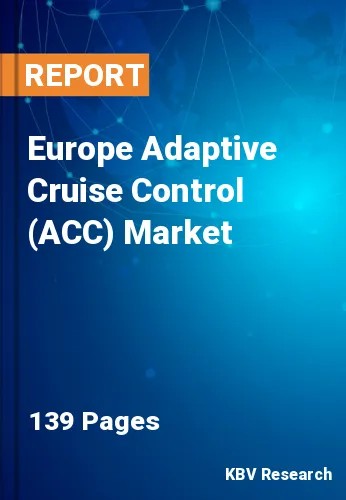Chapter 1. Market Scope & Methodology
1.1 Market Definition
1.2 Objectives
1.3 Market Scope
1.4 Segmentation
1.4.1 Europe Adaptive Cruise Control (ACC) Market, by Product Sales
1.4.2 Europe Adaptive Cruise Control (ACC) Market, by Type
1.4.3 Europe Adaptive Cruise Control (ACC) Market, by Component
1.4.4 Europe Adaptive Cruise Control (ACC) Market, by Vehicle Type
1.4.5 Europe Adaptive Cruise Control (ACC) Market, by Country
1.5 Methodology for the research
Chapter 2. Market at a Glance
2.1 Key Highlights
Chapter 3. Market Overview
3.1 Introduction
3.1.1 Overview
3.1.1.1 Market Composition and Scenario
3.2 Key Factors Impacting the Market
3.2.1 Market Drivers
3.2.2 Market Restraints
3.2.3 Market Opportunities
3.2.4 Market Challenges
Chapter 4. Competition Analysis – Global
4.1 Market Share Analysis, 2023
4.2 Strategies Deployed in Adaptive Cruise Control (ACC) Market.
4.3 Porter Five Forces Analysis
Chapter 5. Europe Adaptive Cruise Control (ACC) Market by Product Sales
5.1 Europe OEMs (Original Equipment Manufacturers) Market by Country
5.2 Europe Aftermarket Market by Country
Chapter 6. Europe Adaptive Cruise Control (ACC) Market by Type
6.1 Europe Standalone ACC Market by Country
6.2 Europe Integrated ACC Market by Country
Chapter 7. Europe Adaptive Cruise Control (ACC) Market by Component
7.1 Europe Radar Sensors Market by Country
7.2 Europe LIDAR Sensors Market by Country
7.3 Europe Ultrasonic Sensors Market by Country
7.4 Europe Cameras & Others Market by Country
Chapter 8. Europe Adaptive Cruise Control (ACC) Market by Vehicle Type
8.1 Europe Passenger Car Market by Country
8.2 Europe Commercial Vehicle Market by Country
Chapter 9. Europe Adaptive Cruise Control (ACC) Market by Country
9.1 Germany Adaptive Cruise Control (ACC) Market
9.1.1 Germany Adaptive Cruise Control (ACC) Market by Product Sales
9.1.2 Germany Adaptive Cruise Control (ACC) Market by Type
9.1.3 Germany Adaptive Cruise Control (ACC) Market by Component
9.1.4 Germany Adaptive Cruise Control (ACC) Market by Vehicle Type
9.2 UK Adaptive Cruise Control (ACC) Market
9.2.1 UK Adaptive Cruise Control (ACC) Market by Product Sales
9.2.2 UK Adaptive Cruise Control (ACC) Market by Type
9.2.3 UK Adaptive Cruise Control (ACC) Market by Component
9.2.4 UK Adaptive Cruise Control (ACC) Market by Vehicle Type
9.3 France Adaptive Cruise Control (ACC) Market
9.3.1 France Adaptive Cruise Control (ACC) Market by Product Sales
9.3.2 France Adaptive Cruise Control (ACC) Market by Type
9.3.3 France Adaptive Cruise Control (ACC) Market by Component
9.3.4 France Adaptive Cruise Control (ACC) Market by Vehicle Type
9.4 Russia Adaptive Cruise Control (ACC) Market
9.4.1 Russia Adaptive Cruise Control (ACC) Market by Product Sales
9.4.2 Russia Adaptive Cruise Control (ACC) Market by Type
9.4.3 Russia Adaptive Cruise Control (ACC) Market by Component
9.4.4 Russia Adaptive Cruise Control (ACC) Market by Vehicle Type
9.5 Spain Adaptive Cruise Control (ACC) Market
9.5.1 Spain Adaptive Cruise Control (ACC) Market by Product Sales
9.5.2 Spain Adaptive Cruise Control (ACC) Market by Type
9.5.3 Spain Adaptive Cruise Control (ACC) Market by Component
9.5.4 Spain Adaptive Cruise Control (ACC) Market by Vehicle Type
9.6 Italy Adaptive Cruise Control (ACC) Market
9.6.1 Italy Adaptive Cruise Control (ACC) Market by Product Sales
9.6.2 Italy Adaptive Cruise Control (ACC) Market by Type
9.6.3 Italy Adaptive Cruise Control (ACC) Market by Component
9.6.4 Italy Adaptive Cruise Control (ACC) Market by Vehicle Type
9.7 Rest of Europe Adaptive Cruise Control (ACC) Market
9.7.1 Rest of Europe Adaptive Cruise Control (ACC) Market by Product Sales
9.7.2 Rest of Europe Adaptive Cruise Control (ACC) Market by Type
9.7.3 Rest of Europe Adaptive Cruise Control (ACC) Market by Component
9.7.4 Rest of Europe Adaptive Cruise Control (ACC) Market by Vehicle Type
Chapter 10. Company Profiles
10.1 Autoliv, Inc.
10.1.1 Company Overview
10.1.2 Financial Analysis
10.1.3 Regional Analysis
10.1.4 Research & Development Expense
10.1.5 SWOT Analysis
10.2 Magna International, Inc.
10.2.1 Company Overview
10.2.2 Financial Analysis
10.2.3 Segmental and Regional Analysis
10.2.4 Research & Development Expenses
10.2.5 Recent strategies and developments:
10.2.5.1 Partnerships, Collaborations, and Agreements:
10.2.6 SWOT Analysis
10.3 Robert Bosch GmbH
10.3.1 Company Overview
10.3.2 Financial Analysis
10.3.3 Segmental and Regional Analysis
10.3.4 Research & Development Expense
10.3.5 SWOT Analysis
10.4 Continental AG
10.4.1 Company Overview
10.4.2 Financial Analysis
10.4.3 Segmental and Regional Analysis
10.4.4 Research & Development Expense
10.4.5 Recent strategies and developments:
10.4.5.1 Product Launches and Product Expansions:
10.4.6 SWOT Analysis
10.5 Denso Corporation
10.5.1 Company Overview
10.5.2 Financial Analysis
10.5.3 Regional Analysis
10.5.4 Research & Development Expense
10.5.5 Recent strategies and developments:
10.5.5.1 Partnerships, Collaborations, and Agreements:
10.6 Valeo SA
10.6.1 Company Overview
10.6.2 Financial Analysis
10.6.3 Segmental and Regional Analysis
10.6.4 Research & Development Expense
10.6.5 Recent strategies and developments:
10.6.5.1 Partnerships, Collaborations, and Agreements:
10.6.6 SWOT Analysis
10.7 Aptiv PLC
10.7.1 Company Overview
10.7.2 Financial Analysis
10.7.3 Segmental and Regional Analysis
10.7.4 Research & Development Expense
10.7.5 SWOT Analysis
10.8 ZF Friedrichshafen AG
10.8.1 Company Overview
10.8.2 Financial Analysis
10.8.3 Regional Analysis
10.8.4 Research & Development Expenses
10.8.5 SWOT Analysis
10.9 Tesla, Inc.
10.9.1 Company Overview
10.9.2 Financial Analysis
10.9.3 Segmental and Regional Analysis
10.9.4 Research & Development Expense
10.9.5 SWOT Analysis
10.10. Nidec Motor Corporation
10.10.1 Company Overview
10.10.2 Financial Analysis
10.10.3 Segmental and Regional Analysis
10.10.4 Research & Development Expenses
10.10.5 SWOT Analysis

